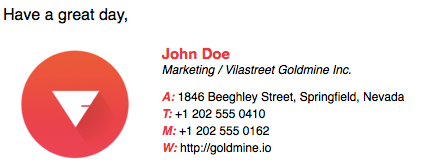Gmail read receipt: Everything you need to know + alternatives
Explore the basics of Gmail read receipts in 2024. Try Mailbutler’s email tracking, as the most reliable alternative to Gmail’s read receipt.
Read our complete guide on how to create a professional email signature with the absolute dos and don’ts and best practices.
James has seven years' experience as a Content Marketer, bylines on Left Foot Forward, Submittable, and INOMICS, and a Master's in History. In his free time he likes to read, play guitar, and write for his personal blog.
An email signature is a must-have, as it helps create a lasting impression for you and your business. A good sign-off can be a make or break for your email. If you’ve just started planning a new signature, or you’ve never created one before, this post is for you.
We'll go through all the most important parts of an email signature, from why you need it, to how you can craft the perfect signature to stay looking professional and on brand.
So why is an email signature so important? The simple answer is this: email signatures grasp attention. With the average worker receiving 121 emails a day, what makes yours stand out in your prospect's inbox is a memorable sign-off line.
Getting the attention of your recipient is essential for marketing, cold emailing, client outreach - you name it.
On top of the fact that it helps you stand out from the crowd, your signature is also an important marketing tool. It allows you, in a small, short, easy-to-find location, to communicate your business offerings and keep your clients in the loop of company updates.
It gives information about exactly who you are, where you can be contacted, and exactly what your business is. And most important, it wraps up each conversation with professionalism.
Your email signature represents you just like a physical business card, but in digital format. What's important to remember is that, depending on how you use your emails for your work, your digital business card will be sent to far more people than a physical one ever would.
You don't have to give it out personally - it's automatically presented every time you send an email. Because so many different recipients will see it, it's important to make sure it's as good as it can be.
What's the purpose of a physical business card? To make a great first impression. With an email signature, the goal is no different.
Your digital business card needs to be informative, in that it provides all the most important information, while remaining easy to read and uncluttered.
Chances are you're creating a signature not just for yourself but to also represent a business or organization. If the signature is for your company, it’s important that the style is aligned with your brand identity.
Try using the same accent colors as your brand logo, like in this example:

It's good to include a few accent colors that highlight your information, but remember to always use the main color which is easy to read. Bright yellows or pinks probably aren't the best bet for readability.
Remember that this email signature also represents your company (unless you're a freelancer) and so should remain professional. Try not to use too many flashy or bright colors, like in this example:

The blue of the sender's name isn't a brand color and doesn't add anything to the signature. Moreover, those bright green colors on the bullet points and the letter initials are difficult to read. Avoid this!
It’s important to consider how people will see your email signature across devices. Emails are often being read on smartphones and tablets, so make sure to check how your signature might appear on a smaller screen or in a portrait view:

This example is a portrait view of the signature that displays perfectly on a smartphone screen. A responsive email signature is crucial, as it’s easier for your recipient to scroll down and access your contact information.
Because most people check their emails on their mobile these days, it's important that it isn't clunky or difficult to view. You want to maximize your chances of getting a response!
A good professional email signature is one that contains the sender’s full name, job title (if the sender’s currently employed), photo, phone number, the company’s physical and website addresses (the latter should be hyperlinked), and social media icons that link to the sender’s and/or company’s profiles.
What’s more, good professional email signatures are visually appealing and don’t include unnecessary information.
Your email signature should include:
When it comes to creating professional email signatures, there are quite a few pieces of information you should and shouldn’t include. Here are the most important email signature dos and don’ts:
Do's
Dont’s
It depends on whether your credentials are relevant to your job title. If the answer is yes, then yes — you should list your academic degree(s), licenses, and certifications. You should first list your permanent credentials and then mention any non-permanent credentials you hold.
The examples above are created with Mailbutler’s signature builder that offers flexible templates with beautiful designs to let you easily customize your information, social links and formalities like closing remarks and disclaimers.
They’re also responsive across devices! Whether a professional-looking signature for business emails or a friendly one for casual messages, Mailbutler ensures you can create your own unique email signature in no time.





Green Signature
12 Nov 2021
Green Signature
12 Nov 2021
Very nice your blog there are many information gotten me from your blog.
12 Nov 2021